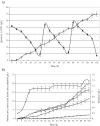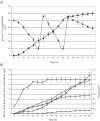Scale-up of anaerobic 1,3-propanediol production by Clostridium butyricum DSP1 from crude glycerol
- PMID: 24555775
- PMCID: PMC3974118
- DOI: 10.1186/1471-2180-14-45
Scale-up of anaerobic 1,3-propanediol production by Clostridium butyricum DSP1 from crude glycerol
Abstract
Background: As the production of biofuels from raw materials continuously increases, optimization of production processes is necessary. A very important issue is the development of wasteless methods of biodiesel production. One way of utilization of glycerol generated in biodiesel production is its microbial conversion to 1,3-PD (1,3-propanediol).
Results: The study investigated the scale-up of 1,3-PD synthesis from crude glycerol by Clostridium butyricum. Batch fermentations were carried out in 6.6 L, 42 L and 150 L bioreactors. It was observed that cultivation of C. butyricum on a pilot scale did not decrease the efficiency of 1,3-PD production. The highest concentrations of 1,3-PD, 37 g/L for batch fermentation and 71 g/L for fed-batch fermentation, were obtained in the 6.6 L bioreactor. The kinetic parameters of 1,3-PD synthesis from crude glycerol established for batch fermentation were similar regarding all three bioreactor capacities. During fed-batch fermentation, the concentration of 1,3-PD in the 150 L bioreactor was lower and the substrate was not completely utilized. That suggested the presence of multifunctional environmental stresses in the 150 L bioreactor, which was confirmed by protein analysis.
Conclusion: The values of effectivity parameters for 1,3-PD synthesis in batch fermentations carried out in 6.6 L, 42 L and 150 L bioreactors were similar. The parameters obtained during fed-batch fermentations in the 150 L bioreactor differed in the rate and percentage of substrate utilization. The analysis of cell proteins demonstrated that a number of multifunctional stresses occurred during fed-batch fermentations in the 150 L bioreactor, which suggests the possibility of identifying the key stages in the biochemical process where inhibition of 1,3-PD synthesis pathways can be observed.
Figures


Similar articles
-
High-level production of 1,3-propanediol from crude glycerol by Clostridium butyricum AKR102a.Appl Microbiol Biotechnol. 2012 Feb;93(3):1057-63. doi: 10.1007/s00253-011-3595-6. Epub 2011 Oct 5. Appl Microbiol Biotechnol. 2012. PMID: 21972131
-
Biorefinery development through utilization of biodiesel industry by-products as sole fermentation feedstock for 1,3-propanediol production.Bioresour Technol. 2014 May;159:167-75. doi: 10.1016/j.biortech.2014.02.021. Epub 2014 Feb 15. Bioresour Technol. 2014. PMID: 24650530
-
Enhanced 1,3-propanediol production by a newly isolated Citrobacter freundii strain cultivated on biodiesel-derived waste glycerol through sterile and non-sterile bioprocesses.J Biotechnol. 2013 Feb 20;163(4):408-18. doi: 10.1016/j.jbiotec.2012.11.018. Epub 2012 Dec 7. J Biotechnol. 2013. PMID: 23220217
-
Utilization of biodiesel derived-glycerol for 1,3-PD and citric acid production.Microb Cell Fact. 2017 Nov 6;16(1):190. doi: 10.1186/s12934-017-0807-5. Microb Cell Fact. 2017. PMID: 29110678 Free PMC article. Review.
-
[Bottlenecks and modification strategies of 1,3-propanediol biosynthesis from glycerol].Sheng Wu Gong Cheng Xue Bao. 2018 Jul 25;34(7):1069-1080. doi: 10.13345/j.cjb.170516. Sheng Wu Gong Cheng Xue Bao. 2018. PMID: 30058306 Review. Chinese.
Cited by
-
Clostridium butyricum population balance model: Predicting dynamic metabolic flux distributions using an objective function related to extracellular glycerol content.PLoS One. 2018 Dec 20;13(12):e0209447. doi: 10.1371/journal.pone.0209447. eCollection 2018. PLoS One. 2018. PMID: 30571717 Free PMC article.
-
Clarification of 1,3-Propanediol Fermentation Broths by Using a Ceramic Fine UF Membrane.Membranes (Basel). 2020 Oct 30;10(11):319. doi: 10.3390/membranes10110319. Membranes (Basel). 2020. PMID: 33143063 Free PMC article.
-
Efficient glycerol transformation by resting Gluconobacter cells.Microbiologyopen. 2019 Dec;8(12):e926. doi: 10.1002/mbo3.926. Epub 2019 Sep 18. Microbiologyopen. 2019. PMID: 31532065 Free PMC article.
-
Isolation and characterization of a newly identified Clostridium butyricum strain SCUT343-4 for 1,3-propanediol production.Bioprocess Biosyst Eng. 2021 Nov;44(11):2375-2385. doi: 10.1007/s00449-021-02610-x. Epub 2021 Jul 7. Bioprocess Biosyst Eng. 2021. PMID: 34231034
References
-
- Monthly Biodiesel Production Report. U.S. Energy Information Administration. Washington, DC 20585, USA; 2013.
-
- Kośmider A, Leja K, Czaczyk K. In: Biodiesel-quality, emissions and by-products. Montero G, Stoytcheva M, editor. Coratia: InTech; 2011. Improved utilization of crude glycerol by-product from biodiesel production; pp. 341–578.
Publication types
MeSH terms
Substances
LinkOut - more resources
Full Text Sources
Other Literature Sources
Molecular Biology Databases
Research Materials

